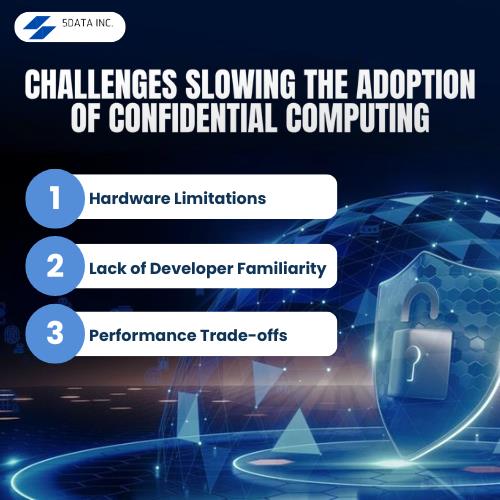In short, confidential computing ensures data confidentiality during all stages of the data lifecycle: at rest, in transit, and in use, which was previously the most vulnerable phase. It’s especially useful in cloud environments where organizations want to keep their data private, even from the cloud provider itself.
In today’s hyper-connected digital world, data is constantly moving, whether between users, apps, or cloud services. With this increased mobility comes greater risk. The very benefits of cloud adoption such as scalability, accessibility, and speed can also create vulnerabilities. That’s where confidential computing comes in: a transformative approach to cloud security that’s quietly reshaping the way organizations protect sensitive data.
Key Takeaways
- Unlike traditional methods that protect data at rest or in transit, confidential computing safeguards data while it’s being processed using Trusted Execution Environments (TEEs).
- By ensuring encrypted workloads remain protected from even cloud providers, this technology supports regulatory compliance for industries like finance, healthcare, and government.
- Confidential computing is driving the shift toward zero-trust architecture, influencing cloud, edge, and multi-cloud environments to make secure-by-default applications the new norm.
Understanding the Shift Toward Confidential Computing
Traditional cloud security methods have largely focused on shielding data at rest and in transit using strong encryption. But what about the data in use? That’s the missing piece in the puzzle: when data is being processed, it often exists in an unencrypted state, leaving it vulnerable to attacks.
Confidential computing solves this by enabling secure processing of data even during runtime. This approach uses trusted execution environments, isolated hardware zones where computation can occur without exposing the data to the rest of the system.
Unlike earlier methods, this technique ensures data confidentiality from not just external threats, but also from cloud service providers themselves. It offers a fundamentally new security architecture, ensuring that even the host machine can’t peek inside the workload being processed.
Why Confidential Computing Is Gaining Ground
Companies face constant pressure to safeguard sensitive data, not only from hackers but also from compliance violations. With regulations like GDPR, HIPAA, and PCI-DSS growing stricter, companies need assurance that their systems meet the highest standards of data compliance.
This is where confidential computing offers unmatched value. It provides verifiable security through trusted hardware, ensuring that no unauthorized entity can access or tamper with encrypted workloads. From financial institutions to healthcare and government agencies, sectors dealing with highly confidential information are rapidly adopting this model.
Moreover, as remote work and multi-cloud setups become the norm, the attack surface for cybercriminals has expanded. In response, cloud protection is no longer optional; it’s essential.
Real-World Applications and Benefits
Let’s consider a few use cases where confidential computing is already making a difference:
1. Financial Services
Banks and financial institutions are turning to this technology for secure workloads, such as credit scoring models or fraud detection algorithms. These workloads involve sensitive data that must remain confidential during processing.
2. Healthcare
Medical data must be protected at all costs. Using TEEs ensures data isolation, making it possible for researchers to analyze patient data collaboratively while keeping the actual data hidden from all parties.
3. AI and Machine Learning
Training AI models require vast datasets, often proprietary or sensitive. Confidential computing ensures these models and their training data remain secure without sacrificing performance.
In all these examples, the focus is on safeguarding not just the encrypted memory but also maintaining cloud privacy and ensuring computing security across the board.
The Role of Confidential Computing in Cloud Architecture
Today’s security architecture demands more than firewalls and intrusion detection systems. It needs solutions baked into the very fabric of how applications run. Confidential computing meets that demand by making private computing the standard, not the exception.
Modern applications benefit from encrypted workloads that can run securely across distributed systems. This includes not just centralized cloud setups but also edge security scenarios where data is processed on IoT devices or at the network’s edge.
It’s also reshaping how organizations approach end-to-end Data Life Cycle Management Services. From collection to deletion, data needs to be secure at every stage, and confidential computing ensures continuity in that protection.
Emerging Trends and Future Outlook
The rise of confidential cloud infrastructure signals a broader move toward zero-trust architecture. In this model, no user or device is automatically trusted, even those within the network. Every component must verify its identity and integrity.
Furthermore, cloud security providers are now integrating confidential computing into their platforms to offer robust end-to-end protection. As a result, Data Collection And Data Management Service Providers are increasingly adopting this approach to ensure their clients’ privacy needs are met.
Even tech startups and software vendors are taking note. Any company positioning itself as the best software application development company must now consider how to integrate confidential computing into its core offerings, especially when handling third-party data.

Addressing Challenges
Like any emerging technology, confidential computing isn’t without its challenges. Adoption can be slowed by:
- Hardware limitations: Not all processors support TEEs yet.
- Lack of Developer Familiarity: Building applications for these environments requires new coding paradigms.
- Performance trade-offs: In some cases, the security gains may come with a slight dip in processing speed.
However, these barriers are diminishing as chipmakers, cloud vendors, and open-source communities collaborate to make confidential computing more accessible.
The Bottom Line
Confidential computing goes beyond being a buzzword. It signals a new direction in how we handle computing security in the cloud era. With the increasing volume and value of data, there’s simply too much at stake to rely solely on outdated models.
By protecting data during all stages of its lifecycle, confidential computing closes the last major gap in cloud security. It’s not just about keeping attackers out; it’s about creating environments where even insiders can’t see or manipulate data.
As adoption increases, we’re moving toward a world where cloud protection, data compliance, and secure workloads are built into every application by default. And in that world, trust is no longer optional; it’s engineered.
Frequently Asked Questions
1. What is confidential computing in simple terms?
It is a technology that protects data while it’s being used by processing it in a secure, isolated environment called a Trusted Execution Environment.
2. How does confidential computing improve cloud security?
It adds a new layer of protection by ensuring sensitive data remains encrypted even during processing, reducing the risk of leaks or insider threats.
3. Is confidential computing suitable for edge devices?
Yes, it enhances edge security by ensuring private data can be securely processed on local devices, reducing latency while maintaining privacy.
4. What industries benefit most from confidential computing?
Sectors handling sensitive data—like finance, healthcare, and government—see the greatest benefits, especially in terms of data compliance and secure workloads.
5. How does confidential computing relate to data compliance regulations?
By providing verifiable protection throughout the data lifecycle, organizations can meet stringent regulatory standards more effectively.

Rasmita Patro
Author
